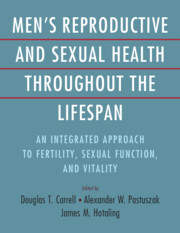 Men's Reproductive and Sexual Health Throughout the Lifespan
Men's Reproductive and Sexual Health Throughout the Lifespan Book contents
- Men’s Reproductive and Sexual Health throughout the Lifespan
- Men’s Reproductive and Sexual Health throughout the Lifespan
- Copyright page
- Contents
- Contributors
- Preface
- Section 1 An Introduction to Men’s Health Care
- Section 2 The Biology of Male Reproduction and Infertility
- Section 3 Clinical Evaluation and Treatment of Male Infertility
- Section 4 Laboratory Evaluation and Treatment of Male Infertility
- Chapter 20 The Modern Semen Analysis
- Chapter 21 The Future of Computer-Assisted Semen Analysis in the Evaluation of Male Infertility
- Chapter 22 Reactive Oxygen Species and Sperm DNA Damage
- Chapter 23 Clinical Value of Sperm DNA Fragmentation Tests
- Chapter 24 The Current Use of Sperm Function Assays
- Chapter 25 Sperm Selection in the Laboratory
- Chapter 26 Methods to Select Ejaculated, Epididymal, and Testicular Spermatozoa for Assisted Conception
- Chapter 27 Optimal Sperm Selection in the ICSI Era
- Chapter 28 Microfluidics for Sperm Sample Preparation and Sperm Identification
- Chapter 29 Practical Concerns for Patient Semen Banking
- Chapter 30 The Potential Future Applications of In Vitro Spermatogenesis in the Clinical Laboratory
- Chapter 31 Spermatogonial Stem Cell Culture and the Future of Germline Gene Editing
- Section 5 Medical and Surgical Management of Issues of Male Health
- Index
- References
Chapter 22 - Reactive Oxygen Species and Sperm DNA Damage
from Section 4 - Laboratory Evaluation and Treatment of Male Infertility
Published online by Cambridge University Press: 06 December 2023
- Men’s Reproductive and Sexual Health throughout the Lifespan
- Men’s Reproductive and Sexual Health throughout the Lifespan
- Copyright page
- Contents
- Contributors
- Preface
- Section 1 An Introduction to Men’s Health Care
- Section 2 The Biology of Male Reproduction and Infertility
- Section 3 Clinical Evaluation and Treatment of Male Infertility
- Section 4 Laboratory Evaluation and Treatment of Male Infertility
- Chapter 20 The Modern Semen Analysis
- Chapter 21 The Future of Computer-Assisted Semen Analysis in the Evaluation of Male Infertility
- Chapter 22 Reactive Oxygen Species and Sperm DNA Damage
- Chapter 23 Clinical Value of Sperm DNA Fragmentation Tests
- Chapter 24 The Current Use of Sperm Function Assays
- Chapter 25 Sperm Selection in the Laboratory
- Chapter 26 Methods to Select Ejaculated, Epididymal, and Testicular Spermatozoa for Assisted Conception
- Chapter 27 Optimal Sperm Selection in the ICSI Era
- Chapter 28 Microfluidics for Sperm Sample Preparation and Sperm Identification
- Chapter 29 Practical Concerns for Patient Semen Banking
- Chapter 30 The Potential Future Applications of In Vitro Spermatogenesis in the Clinical Laboratory
- Chapter 31 Spermatogonial Stem Cell Culture and the Future of Germline Gene Editing
- Section 5 Medical and Surgical Management of Issues of Male Health
- Index
- References
Summary
Over the last decade it has become increasingly clear that semen analysis is insufficient to diagnose male infertility. With 30% of infertile men diagnosed as idiopathic, the ethics of continuing to rely on outdated diagnostic parameters must be questioned. Sperm DNA damage is a strong biomarker of male infertility. It also correlates significantly with increased risk of miscarriage after both natural and ART conception. Thirdly, sperm DNA damage is a useful predictive tool for both IVF and ICSI live birth success. DNA fragmentation can occur as double or single strand breaks. Oxidative stress is a common cause of single strand breaks and can be prevented by endogenous and dietary supplemented antioxidants. In contrast, double strand breaks are caused by dysfunction during spermatogenesis, and are harder for oocytes to repair post fertilization. Greater awareness of the relevance of DNA damage and its origins could aid fertility choices and outcomes.
Keywords
- Type
- Chapter
- Information
- Men's Reproductive and Sexual Health Throughout the LifespanAn Integrated Approach to Fertility, Sexual Function, and Vitality, pp. 175 - 182Publisher: Cambridge University PressPrint publication year: 2023


